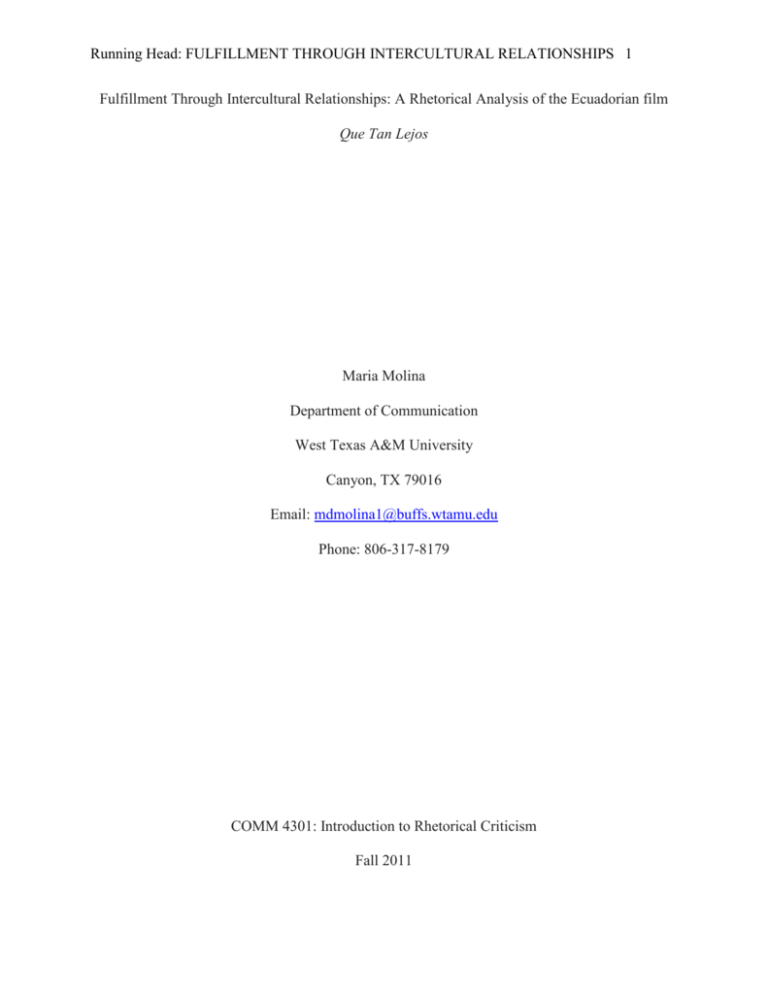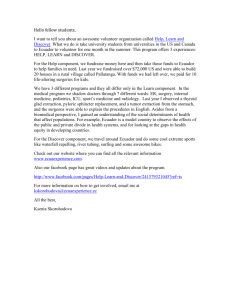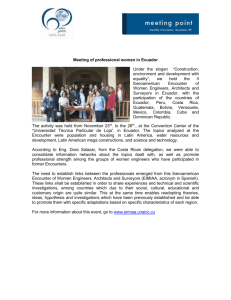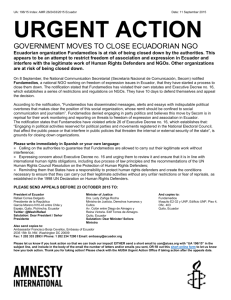File
advertisement

Running Head: FULFILLMENT THROUGH INTERCULTURAL RELATIONSHIPS 1 Fulfillment Through Intercultural Relationships: A Rhetorical Analysis of the Ecuadorian film Que Tan Lejos Maria Molina Department of Communication West Texas A&M University Canyon, TX 79016 Email: mdmolina1@buffs.wtamu.edu Phone: 806-317-8179 COMM 4301: Introduction to Rhetorical Criticism Fall 2011 FULFILLMENT THROUGH INTERCULTURAL RELATIONSHIPS 2 Abstract This paper uses Generative Criticism to demonstrate the strength of intercultural relationships when developing an understanding of self. Focusing on the film Que Tan Lejos, this paper analyzes how intercultural relationships are a stronger force than social identity. The director, Tania Hermida, uses symbols in order to define the typical Ecuadorian citizen. She also contrasts the main characters’ pessimism and positivism in order to give a social identification of each. Hermida depicts how despite their strong social identity, the characters’ friendship and intercultural relationship forces them to reevaluate their idea of fulfillment. This analysis focuses on the character of Tristeza and her development throughout the film. Key words: Social Identity Theory, intercultural relationships, pessimism, positivism, Que Tan Lejos FULFILLMENT THROUGH INTERCULTURAL RELATIONSHIPS 3 Fulfillment Through Intercultural Relationships: A Rhetorical Analysis of the Ecuadorian film Que Tan Lejos Not two people have the same goals in life or the same idea of fulfillment. People experience different events that shape their personality and identity. Many believe that the main way in which a person reaches an understanding of self is through social identity. In other words, the different beliefs and values that we grow up in are the main factors that shape human beings. However, I argue that intercultural relations are a stronger force than social identity when it comes to a person’s establishment of fulfillment. In this paper I use Generative Criticism to examine the tension between social identity and intercultural relationship in the Ecuadorian film Que Tan Lejos directed by Tania Hermida. Description of the Artifact For this analysis I use the movie Que Tan Lejos (Hermida), an Ecuadorian comedy directed by Tania Hermida, filmed entirely onsite. The film depicts the Ecuadorian culture and its positive and negative aspects. Many have characterized the film as a “portrait of Ecuadorian life” (Que tan lejos, 2008), which cannot really be understood by viewers who have not been in Ecuador. The film is not only a reflection of the culture, but also a critique of how the society we are raised in shapes our idea of fulfillment. The 2006 production tells the story of Esperanza, a Spanish tourist, as she crosses paths with Tristeza, a cynical and pessimistic Ecuadorian student. Esperanza, on one hand, has an energetic personality as she loves to travel and experience life. Conversely, Tristeza is tired of picturesque South America and learns the love of her life is getting married in Cuenca so she FULFILLMENT THROUGH INTERCULTURAL RELATIONSHIPS 4 decides to go to the city and stop the wedding. The characters meet at the bus going to Cuenca. After being stranded in the countryside because of a strike, both characters attempt to travel to their destination by any means possible. In their journey they encounter a man, Jesus, transporting the ashes of his grandmother who died. He also needs to travel to Cuenca, so he joins both women in the journey (Hermida, 2006). As their trip continues the two women are prompted to “reevaluate their expectations regarding their quest for fulfillment” (Buchanan, 2006). In this paper, I focus on Tristeza and her particular search for self-realization. The director, Tania Hermida was born in Cuenca, Ecuador in 1968. During her childhood, Hermida moved and lived in different places because of her father’s job. Despite her constant relocations she maintained a close link to her native city and her family. When she graduated, she entered the medical field, however she soon realized that was not the place for her. She then tried different artistic fields and discovered her passion for the film industry. Since Ecuador did not offer any education in filmmaking, she went to the “Escuela Internacional de Cine y TV de San Antonio de Los Baños” in Cuba. The school taught Hermida a different approach to film. “It was proposed to reinvent film based on what we are as a culture. It was not only based on technique or art, but also in the search and opening paths,” she said (Tania Hermida, n.d.). In 1992 she returned to Ecuador and faced a country in which the film industry was not popular. She then completed her Masters degree in Cultural Studies and travelled to Cuba, the United States, Spain and Chile. However, she realized her future was in Ecuador and not abroad. In her return to her home country Hermida participated with other colleagues in the creation of the “Corporación Ecuador para Largo,” (Tania Hermida, n.d.) a corporation for the development, production and distribution of the independent films (Nosotros-Corporación, n.d.). The idea of FULFILLMENT THROUGH INTERCULTURAL RELATIONSHIPS 5 working on her first full-length film was born (Tania Hermida, n.d.). In 2003, Hermida started writing what became Que Tan Lejos. The film has been seen by more than 200,000 viewers in Ecuador and received international acclaim as well. In fact, the film won two awards: “El Zenith de Plata de Óperas Primas en Festival de Cine de Montréal” and the second award in the “Festival Internacional del Nuevo Cine Latinoamericano de Cuba” (Tania Hermida, n.d.). Ecuador’s history and current status In many aspects, Ecuador’s history has been a major factor in the development of the national identity of its population (Ecuador, 2011). Therefore, in order to understand the Ecuadorian people it is important to understand their history. The first inhabitants of the country settled along the coast and central highlands as far back as 20,000 B.C. Later, agrarian cultures established settlements and developed navigation, distinct art, religion and trade that reached as far north as Central America. In the mid 15th century, the Incas, based in Peru, attacked these settlements and imposed their culture. However, in 1532, the Spaniards led by Francisco Pizzarro fought the Incas and conquered Ecuador. “The Spanish named their conquered territory the Audiencia de Quito” (Alfaro, 2010). After various years of Spanish rule, Ecuador got its independence led by Antonio José de Sucre. His troops defeated the Spaniards on May 24, 1822 in the flanks of Pichincha volcano, in what is known as the Battle of Pichincha (Alfaro, 2010). After the Battle of Pichincha, the country joined the Confederation of Gran Colombia, which also included present day Colombia and Venezuela (Ecuador, 2011). In 1839, Ecuador became an independent republic “and began a tumultuous history racked with ethnic clashes and dominated by a white, European-oriented oligarchy” (Ecuador, 2011). FULFILLMENT THROUGH INTERCULTURAL RELATIONSHIPS 6 Since its independence, Ecuador has experienced political and cultural conflicts. Ecuador has been in general free from international conflict. However, the territorial conflicts with Peru that started in 1941 and ended with the 1998 peace agreement, marked an unstable era (Lee & Halcli, 2011). Politically, Ecuador has been marked by instability and violence. Through the 20th century provisional governments and military juntas governed the country. It was not until 1979 that democratic rule was restored. Currently, Ecuador’s leader is Rafael Correa who has been the 12th president to serve since democracy was restored in 1979 (Alfaro, 2010). Today, Ecuador has an area of 276, 849 square kilometers and has a population of 14,306,876 as of the 2010 census. The official language is Spanish, however several indigenous languages, especially Quichua, are still present (Republic of Ecuador, 2011). An average of 33 percent of the population are below the poverty line and the unemployment rate averages 7.6 percent as of 2010 (South America: Ecuador, 2011). Methodology The method I use for this analysis is Generative Criticism. Foss (2009) explains the critic uses nine steps when engaging in this type of criticism: encountering a curious artifact, coding the artifact in general, searching for an explanation, creating an explanatory schema, formulating a research question, coding the artifact in detail, searching the literature, framing the study and writing the essay (p. 387). In the first step the critic finds an artifact of interest. According to Foss (2009), the artifact that intrigues a critic is likely to be something that doesn’t fit or doesn’t follow a particular pattern. After encountering the artifact, the critic codes the artifact. “In this process of identifying major features of the artifact, use intensity and frequency as your selection criteria” FULFILLMENT THROUGH INTERCULTURAL RELATIONSHIPS 7 (Foss, 2009, p. 389). After examining the artifact several times, more information about the artifact’s major elements and their relationships are evident. The next two steps are to search for an explanation of the artifact and create an explanatory schema. “What is most likely to happen after searching for an explanation of you artifact is that you will find a theory or construct that explains some pieces of your artifact but not all of them” (Foss, 2009, p. 394). If a conventional explanation for the artifact does not exist, the critic must develop an explanatory schema. “An explanatory schema is a framework for organizing your insights about the artifact in a coherent and insightful way” (Foss, 2009, p. 394). This explanatory schema does not only provide an explanation for the artifact, but it also serves as the structure of the essay the critic writes. Once the explanatory schema answers the questions that led the critic into an explanation of the artifact, the critic formulates a research question. The critic then codes the artifact one more time. This time, using the elements of the explanatory schema. Foss describes that through this process “you are developing the explanatory schema you have seen until now only in general terms, working on kinks conceptualizing aspects of it you did not think through before, refining it, and extending it” (Foss, 2009, p. 401). When the critic has a schema that explains the artifact insightfully and comprehensibly, the critic does a small literature review of the key concepts of the schema. When coding the literature, the critic identifies ideas that are relevant for the criticism. The last step before writing the essay is to decide how to frame the explanatory schema “so that it can contribute to a significant conversation in the communication discipline” (Foss, 2009, p. 403). After the analysis has been completed the critic writes the essay. As part of step four of Generative Criticism, the critic creates an explanatory schema of FULFILLMENT THROUGH INTERCULTURAL RELATIONSHIPS 8 the artifact. I use Social Identity Theory developed by Tajfel and Turner (Tajfel, 1982). According to Tajfel (1982), the term “is understood as the part of the individuals´ self-concept which derives from their knowledge of their membership of a social group (or groups) together with the value and emotional significance attached to their membership” (p. 2). In this theory the self is reflexive, meaning that “it can take itself as an object and can categorize, classify, or name itself in particular ways in relation to other social categories or classifications” (Stets, 2000, p. 224). In Social Identity Theory this process is referred to as self-categorization, through which identity is formed. In Social Identity Theory, a social identity is defined as the person’s knowledge that he or she belongs to a social group or category. Stets (2000) defines social group as “a set of individuals who hold a common social identification or view themselves as members of the same social category” (p. 225). Self-categorization and social comparison produce different consequences. The consequence of self-categorization is the accentuation of perceived difference between the members of the social group and those outside. “This accentuations occurs for all the attitudes, beliefs and values, affective reactions, behavioral norms, styles of speech, and other properties that are believed to be correlates with the relevant intergroup categorization” (Stets, 2000, p. 225). On the other hand, the consequence of social comparison is the application of the accentuation effect in a selective manner. This is done to self-enhance outcomes of the self. According to Stets (2000), people develop their identity or sense of self largely based on the social category to which they belong. However, each person is a member of a combination of social categories experienced through life. Therefore, the “set of social identities making up that person’s self-concept is unique” (Stets, 2000, p. 225). Social Identity Theorists recognize that individuals construct their sense of selves in terms of the meanings conveyed by a structured FULFILLMENT THROUGH INTERCULTURAL RELATIONSHIPS 9 society. Analysis In this analysis I focus on Tristeza and her development throughout the film in order to show how intercultural relations are a stronger force than social identity when it comes to a person’s sense of fulfillment. This analysis is divided in four sections. The first explains the different symbols, which form the typical Ecuadorian citizen’s beliefs and values. These symbols form the social identity of the citizens in Ecuador. The second contrasts the idea of pessimism and positivism, which help to define the main characters of the film and their interactions. The third section explains the difference in social identity between Tristeza and Esperanza based on their culture and country of birth. The final section analyzes reevaluation and how the friendship developed with Esperanza helps Tristeza to realize what was wrong in her life, inspiring her to change her goals and aspirations in her life. A Typical Ecuadorian Historically, Ecuador has been a country that has struggled in its politics and economy. This is reflected in the film through the “paro” or strike in the movie. This event is a typical event in Ecuador. The majority of times people cannot even identify the reason for the strikes. In Que Tan Lejos, the strike symbolizes instability in the country, which in turn leads to a lack of self-esteem of the citizens of Ecuador. It also causes citizens to view their country in a negative light despite other positive aspects the country has. This is evident through the girl the characters meet when they make a stop during their trip. When Esperanza says that Ecuador is beautiful the girl replies, “ Of course something different is to do tourism, but all foreign people like it, apparently Ecuador is pretty” (Hermida, 2006). The girl’s tone of voice is negative when talking about Ecuador, something typical of Ecuadorian citizens. Despite having a country rich in FULFILLMENT THROUGH INTERCULTURAL RELATIONSHIPS 10 natural resources and scenery, citizens are unable to view the beauty of their country and only emphasize the negative aspects of it. Another cultural reflection portrayed in Que Tan Lejos is the lady that Esperanza and Tristeza meet at the bus. The lady is with her daughter who tells her mother she is thirsty. When Esperanza offers her water, the lady gets upset with the girl and tells her she is spoiled and impolite. After Esperanza gives her water, the child stops talking and only repeats what her mother tells her to say (Hermida, 2006). This event symbolizes how Ecuadorians are raised with the fear of being reprimanded for everything they do. Citizens are culturalized with the idea that they are never going to do something totally right, placing themselves in the position of the victim. The idea of victimization is also seen when the taxi driver at the beginning of the film leaves Esperanza at her hotel. When Esperanza pays him, he has no change and says he does not think the $5 matter because in Spain they make a lot of money. Esperanza gets upset at this, but decides to walk away saying “this is a robbery” (Hermida, 2006). The taxi driver replies that his uncle was right when he said to be careful with the Spanish. According to him they already took all the treasures from the Incas and now they come pretending to be better (Hermida, 2006). This example reinforces the idea of history. Since Spaniards conquered Ecuador, the country has constantly lost wars and land. This has had a negative connotation on citizens who now play the victim’s role and think of the country as inferior. However, not all symbols in Que Tan Lejos portray Ecuadorian as negative and with a pessimistic view. The film also depicts the Ecuadorian society as friendly and engaged in conversation. An example is when Andrés, a secondary character, hears on the radio that his soccer team scored a goal. He gets out of the car with his team’s flag and starts dancing and FULFILLMENT THROUGH INTERCULTURAL RELATIONSHIPS 11 celebrating (Hermida, 2006). This scene reflects the importance of soccer to citizens and how it is a means through which citizens become unified. There are countless examples of Ecuadorians’ happiness and willingness to help each other. In fact, in every stop the main characters make, they encounter different people that help them. Despite the strike, the characters have no difficulty getting to Cuenca because they always find someone to help. The movie depicts how the aforementioned symbols help shape the Ecuadorian society giving citizens a sense of belonging. This symbols form a very important part of citizens’ lives and ultimate goals. Tristeza is a typical Ecuadorian, however the relationship she forms with Esperanza helps her develop as a person. Even though she has a strong social identity, what she learns from Esperanza helps her change her overall goal. Pessimism vs. Positivism The idea of fulfillment in Que Tan Lejos is seen through the personalities of the two main characters. On one hand, Tristeza (Sadness) depicts the typical pessimism of Ecuadorian citizens, which, as mentioned earlier, has been a characteristic developed throughout history. She is always complaining about situations without really applying a good logic to them. For example, when the characters encounter the “paro” or strike, Tristeza tries to explain why she is in favor of it. However, she is not able to get her idea across with logic and facts. On the other hand, Esperanza (Hope) is always trying to see the positive aspects in situations. She is always filming with her hand held camera, capturing the beautiful scenery of Ecuador. The character explains she always films when she travels so she can capture the moments she likes (Hermida, 2006). Another example depicting the concepts of pessimism vs. positivism is the vague goals that each women has at the beginning of the film. On one hand, Tristeza is convinced that she wants to stop her “boyfriend’s” wedding, but she is not even sure if he is still her boyfriend or FULFILLMENT THROUGH INTERCULTURAL RELATIONSHIPS 12 not. According to her, his parents are forcing him to get married, but she is not really sure about what her relationship status is. Every time she mentions her “boyfriend’s” family she refers to them in negative terms. For example when Tristeza explains the situation to Esperanza and Jesus, she refers to them as “aniñados” and “curuchupas” (Hermida, 2006). In Ecuador these terms are used to refer to high-class people in a degrading way. However, she does not know her “boyfriend’s” parents and she does not know if her “boyfriend” actually wants to get married or not. As the movie develops, she gives clues to let the audience realize that he wants to get married and is not really interested in Tristeza at all. Even though deep inside she knows this, Tristeza is still determined to stop the wedding. On the other hand, Esperanza seems to be sure about her self, but reveals she actually questions her objectives. When Tristeza and Esperanza are sitting in the mountains after they got out of the bus Esperanza says, “It is so weird to be here” (Hermida, 2006). She explains this questioning tends to occur when she is traveling and she asks herself who she is and what is she doing so far away from home. Even though she questions her goals, she says she always carries a picture of herself as a small girl. In the picture she is smiling, symbolizing that even if her goals are not clear, Esperanza likes to maintain a positive attitude. Social Identity Through the previous sections of this analysis, the social identification of Tristeza and Esperanza are evident. In the case of Tristeza, she self-categorizes herself as a typical Ecuadorian who has developed a pessimistic view of the world. As a consequence of this self-categorization, there is an accentuation of the differences between both characters, which is revealed through the contrast between Tristeza’s pessimism and Esperanza’s positivism. This dichotomy is what causes the characters to develop through their friendship and in turn reevaluate their idea of FULFILLMENT THROUGH INTERCULTURAL RELATIONSHIPS 13 fulfillment and goals in life. In other words, despite their strong social identification, the intercultural relationship between the characters is a stronger force that prompts the characters to adapt to each other and take aspects from each culture in order to reach a better understanding of fulfillment. Reevaluation The main characters’ friendship helps them to learn from each other and reevaluate their goals and objectives. As mentioned earlier, this analysis focuses on Tristeza and her development throughout Que Tan Lejos. Even though Esperanza was the main influence of her reevaluation, the catalyst of change is when she sees her “boyfriend” at his wedding. He is happy and when he sees Tiristeza, he ignores her and kisses his wife (Hermida, 2006). Tristeza then realizes she needs to change and decides to apply what she learned from Esperanza in order to redefine her idea of fulfillment. After the wedding, Tristeza and Esperanza go to the river to throw Jesus’ grandmother’s ashes. Jesus forgot them on the bus and left as both women fell asleep in the bus. They decide to finish Jesus’ journey. His grandmother’s will was for her ashes to be thrown in the Tomebama river in Cuenca (Hermida, 2006). This event also serves as a symbol of transition and the beginning of a new quest for fulfillment. Tristeza is willing to set new goals in her life and the throwing of the ashes symbolizes the willingness the character has to adapt and learn from Ezperanza. She is throwing away the past and starting again with new goals in mind. In the last scene of the film Tristeza reveals her real name, Teresa, which also symbolizes the willingness of the character to leave her pessimism behind. As mentioned previously, Tristeza means sadness. The character wants to leave that sadness behind and apply her friend’s concept of positivism to continue with her life. During this last scene, Teresa says, “It is so weird FULFILLMENT THROUGH INTERCULTURAL RELATIONSHIPS 14 to be here” (Hermida, 2006). She applies the way of thinking that Esperanza had. She knows she does not have her life completely figured out, however she knows one thing: she wants to be happy and leave pessimism behind. She starts to question the idea of fulfillment she previously had and knows it is time to redefine and reevaluate her life. Que Tan Lejos is a film that has helped shape the perceptions Ecuadorians hold about their culture. Rybacki and Rybacki (2002), explain that through films a person can visualize the past, gain insight of the present, and speculate about the future. Herminda’s film helps define Ecuadorian social trends and how the past has played an important role in shaping those trends. Similarly, it challenges Ecuadorians into changing some aspects of their culture and adapting ways of thinking from other cultures. Through the Ecuadorian characters in the film, especially Tristeza, citizens have a clear portrayal of the negative and positive aspects of their culture. This makes them question their society and challenge their perceptions and sense of fulfillment. Conclusion Despite the common belief that social identity are the primary way in which a person reaches an understanding of self, Que Tan Lejos demonstrates that intercultural relationships is an even stronger force. Through the film, Director Tania Hermida depicts the typical Ecuadorian citizens and their pessimism. She shows the dichotomy between Tristeza, who is Ecuadorian, and Esperanza, from Spain. However, she portrays how through her friendship with Esperanza, Tristeza is able to reevaluate her goals in life. Triztesa takes the aspects she likes from Esperanza and incorporates them in her own life in order to change her understanding of fulfillment. Implications for Further Research This study uses Generative Criticism and Social Identity Theory, however other methods of criticism could also be applied to analyze Que Tan Lejos. An Ideological Criticism analysis of FULFILLMENT THROUGH INTERCULTURAL RELATIONSHIPS 15 this artifact could lead to an understanding of the ideologies formed through the film. Another effective method for analyzing the movie is Metaphoric Criticism. Metaphors illustrated in the artifact could also lead to a better understanding of the film. Another area of future study in Que Tan Lejos is an analysis of how history influences the development of a country’s self-esteem. The film reveals the resentment of Ecuadorians towards the Spanish because of history. An analysis of this sentiment could add to the understanding of self-identification, social identity and intercultural relationships. FULFILLMENT THROUGH INTERCULTURAL RELATIONSHIPS 16 References Alfaro, E. (2010). Ministry of tourism of ecuador. Retrieved from http://ecuador.travel/en/aboutecuador/ecuador-history/ecuador-history.html Buchanan, J. Que tan lejos (2006). The New York Times. Retrieved from http://movies.nytimes.com/movie/375442/Que-Tan-Lejos/overview Ecuador. (2011 s). Retrieved from http://www.everyculture.com/Cr-Ga/Ecuador.html Foss, S. K. (2009). Rhetorical criticism: Exploration and practice (4th ed.). Long Grove, IL: Waveland Press. Hermida, T. (Director) (2006). Que tan lejos [DVD]. Lee, R., & Halcli, J. (2011). Ecuador-peru border war. Retrieved from http://www.historyguy.com/Ecuador-Peru_War_of_1941.html Nosotros- Corporación. (n.d.). Retrieved from http://ecuadorparalargo.com/nosotros/ Que tan lejos: Ecuador's cinematic pride and joy asks "are we there yet?". (2008, December 28). Retrieved from http://www.epinions.com/content_455860522628 Republic of Ecuador. (2011). Retrieved from http://www.state.gov/r/pa/ei/bgn/35761.htm Rybacki, K & Rybacki, D. (2002). Communication criticism: Approaches & genres. Boston, MA: Person Custom Publishing. Social identity theory. (n.d.). Retrieved from http://www.utwente.nl/cw/theorieenoverzicht/Theory clusters/Interpersonal Communication and Relations/Social_Identity_Theory.doc/ South America: Ecuador. (2011). Retrieved from https://www.cia.gov/library/publications/theworld-factbook/geos/ec.html FULFILLMENT THROUGH INTERCULTURAL RELATIONSHIPS 17 Stets, J. E. (2000). Identity theory and social identity theory. Social Psychology Quarterly, 63(3), 224-237. Retrieved from http://wat2146.ucr.edu/papers/00a.pdf Tajfel, H. (Eds.). (1982). Social identity and intergroup relations. New York, NY, Cambridge University Press. Tania Hermida. (n.d.). Retrieved from http://www.fundaciontiana.org/taniahermida.html





